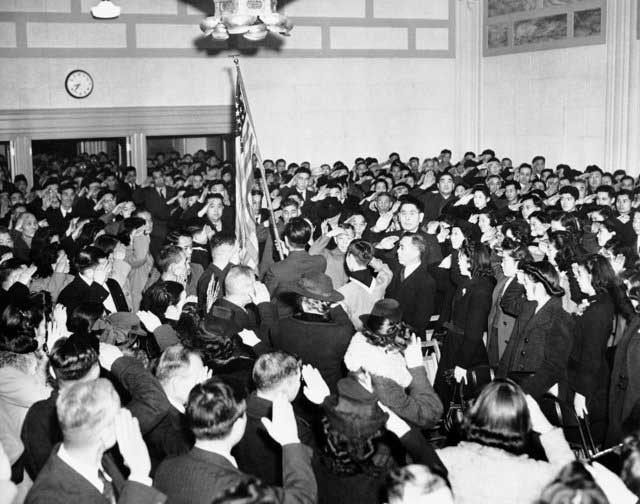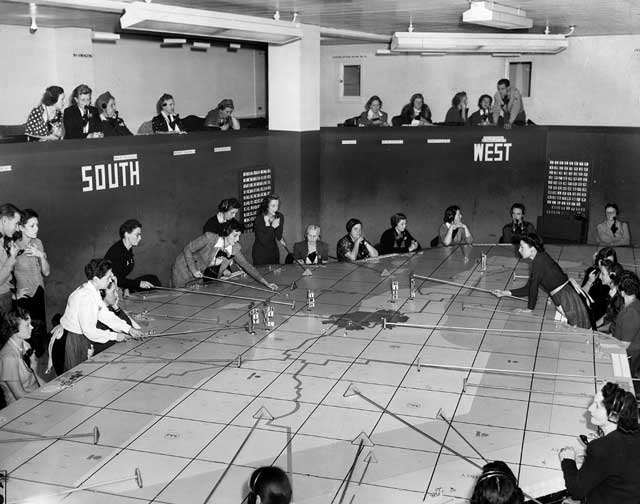Saturday 13 December 1941
 |
| U-126 returning to its port of Lorient, France, 13 December 1941 (Tölle, Alwin, Federal Archive Bild 101II-MW-4362-40). |
Battle of the Mediterranean: Events on land in the Mediterranean basin invariably revolve around sea battles. General Erwin Rommel has been frantic to get more supplies delivered from Naples to Tripoli via Palermo. In the early morning hours of
13 December 1941, the Italians send the cruisers Alberto da Barbiano and Alberico di Giussano across the Strait of Sicily.
 |
| Italian cruisers Alberico Da Barbiano and Alberto Di Giussano docked side by side in the 1930s. These are the two ships sunk by the Royal Navy on 13 December 1941. |
The cruisers are packed with fuel barrels on deck that carry 100 tons of aviation fuel, 250 tons of gasoline, and 600 tons of naphtha, among other supplies. Also making the crossing are 135 ratings. The cruisers are not meant to serve as cargo ships, so the fuel barrels are stacked high and limit the ability to fire the main guns. The British, meanwhile, have learned of the convoy via their Ultra service and have sent the 4th Destroyer Flotilla to intercept them. The stage is set for a deadly confrontation.
 |
| Commander Lieutenant Ernst Bauer of U-126 shortly after returning to Lorient, France on 13 December 1941 (Tölle, Alwin, Federal Archive Picture 101II-MW-4363-06). |
The Royal Navy ships, knowing exactly where to look for them and lying in wait, spot the two unaware Italian cruisers near Cape Bon, Tunisia around 02:30. Hugging the coast, which causes them to blend into the background, the British destroyers remain undetected until they are close enough to launch torpedoes and open fire with their main guns. The outcome is extremely similar to that of the Battle of Cape Matapan in March 1941. Once they become aware of the British trap, the Italian ships immediately reverse course, but Barbiano is hit by a torpedo, bursts into flames due to the fuel barrels being hit, and then is hit with several more torpedoes. Meanwhile, Giussano also is hit by gunfire and a torpedo, leaving her dead in the water. Neither ship has a chance. Barbiano sinks at 03:35 and Giussano at 04:20. The Italians lose 817 men. Italian destroyer Cigno picks up about 500 men in the water, Italian torpedo boats rescue another 145, and other men manage to swim to shore. All of the fuel for Rommel's tanks goes to the bottom.
The bottom line? Knowing ahead of time what your enemy is about to do gives you lots of ways to beat them.
 |
| U-126 approaching the dock in Lorient, France after a patrol on 13 December 1941. That is likely Admiral Doenitz on the dock saluting, he often personally greeted returning submarines (Tölle, Alwin, Federal Archive Picture 101II-MW-4362-37). |
On land, the New Zealand 5th Brigade attacks the new Afrika Corps Gazala line along an 8-mile front while the 5th Indian Infantry Brigade makes a flanking attack against the Italian Trieste Division at Alem Hamza. The New Zealand troops make some headway, taking point 204 a few miles west of Alem Hamza, but the Germans quickly counterattack with 39 panzers and accompanying infantry. Both sides take heavy casualties (the Germans lose 15 panzers), but the New Zealand troops hold their exposed position. The British plan to reinforce them on the 14th and attack again early on the 15th.
 |
| U-126 approaching the dock on 13 December 1941, crew lined up on deck, commander Bauer saluting (Tölle, Alwin, Federal Archive Picture 101II-MW-4362-38). |
Eastern Front: Faced with frantic calls for help from the Moscow front, German Army commander Field Marshal Walther Brauchitsch arrives at Army Group Center headquarters in Smolensk shortly before noon. He listens as Field Marshal Fedor von Bock and the generals advise that further withdrawals are necessary, to a line centered on Rzhev-Gzhatsk-Orel-Kursk. Supported by Field Marshal von Kluge, who is overseeing Third and Fourth Panzer Armies, and General Adolf Strauss of Ninth Army, von Bock warns that the entire German front may be "smashed to pieces" without a timely withdrawal. Brauchitsch does not make any decisions today, as they are being made without him, but plans on talking to General Guderian (who, having withdrawn from Tula, now is having trouble holding his new line further west) and other generals on the 14th.
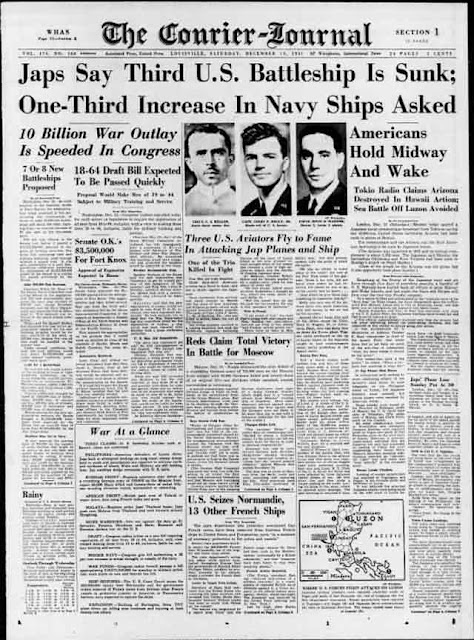 |
| The Louisville, Jefferson, Kentucky Courier-Journal of 13 December 1941. Buried deep under the Pacific war news is a headline stating "Reds Claim Total Victory in Battle for Moscow," which is quite accurate at this point and much more significant than anything else on the page. |
Battle of the Pacific: In the Hawaiian Islands, a bizarre postscript to the attack on Pearl Harbor ends on 13 December 1941 when a Japanese pilot, Airman First Class Shigenori Nishikaichi, who crash-landed during the attack, is killed on Niihau Island. This becomes known as the "Niihau incident." Nishikaichi has remained at large on the island for the past five days because there are no radios and also because he has gained some allies. However, after a wild melee, island residents overcome the mini-rebellion in hand-to-hand combat. One woman, Irene Harada (of Japanese descent), is imprisoned until June 1944 for helping the Japanese pilot but never convicted of any crimes. The incident contributes to fears that Japanese residents in the United States may secretly aid the Imperial Japanese government, as indicated in a 26 January 1942 Navy report by Lieutenant C.B. Baldwin.
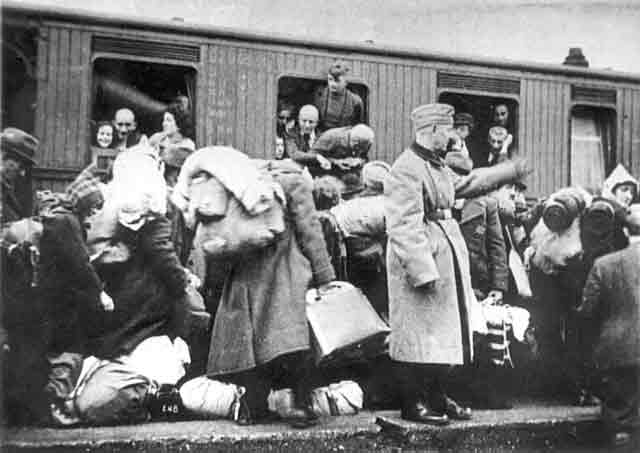 |
| German Jews being deported from Muenster, Germany to the Ghetto at Riga, Latvia. The Riga Ghetto has recently had space freed up due to mass exterminations there (Yad Vashem Photo Archives 4981/46). |
The Japanese advance on the Malay Peninsula continues as the Japanese take Jitra. The 11th Indian Division successfully withdraws late on the 13th, but it is poorly executed and many advanced units remain while the bulk of the division leaves after dark. The area commander, General Percival, later writes:
This withdrawal would have been difficult under the most favourable conditions. With the troops tired, units mixed as the result of the fighting, communications broken and the night dark, it was inevitable that orders should be delayed and that in some cases they should never reach the addressees. This is what in fact occurred. Some units and sub-units withdrew without incident. Others, finding themselves unable to use the only road, had to make their way as best they could across country.
Going "across the country" means troops hauling whatever equipment they can carry, struggling through jungles with no roads and finding many natural obstacles. The withdrawing Indian troops reach the south bank of the River Kedah around midnight, but the division has taken very heavy losses both from combat and the botched withdrawal. The Indian troops know they cannot hold this position for long, so they begin retreating to a position 30 miles south of Jidrah in southern Kedah.
 |
| "USS Helena (CL-50), December 1941. The image shows the torpedo damage received on December 7, 1941, during the Japanese raid on Pearl Harbor. Specifically shown is between frames 69.5 and 80.5 starboard side below armor belt. Note that the bilge keel is split along a line of rivets. Photographed at Pearl Harbor Navy Yard, Pearl Harbor, Territory of Hawaii, December 13, 1941. Official Bureau of Ships Photograph, now in the collections of the National Archives. (2015/2/18)." National Museum of the U.S. Navy. |
At Hong Kong, the last Commonwealth troops, the 5/7 Rajputs of the Indian Army under the command of Lieutenant R. Cadogan-Rawlinson, evacuate to Hong Kong Island. The Japanese close in on the Kowloon waterfront and make their first surrender demand, which is rejected by the Governor of Hong Kong, Sir Mark Aitchison Young. The British organize their defense into a West Brigade (Canadian Brigadier J.K. Lawson) and an East Brigade (British Brigadier C. Wallis). The officer commanding in Hong Kong, British Major General Christopher Maltby, fears a seaborne invasion, so he deploys many troops on the southern beaches when the real threat emanates from the north.
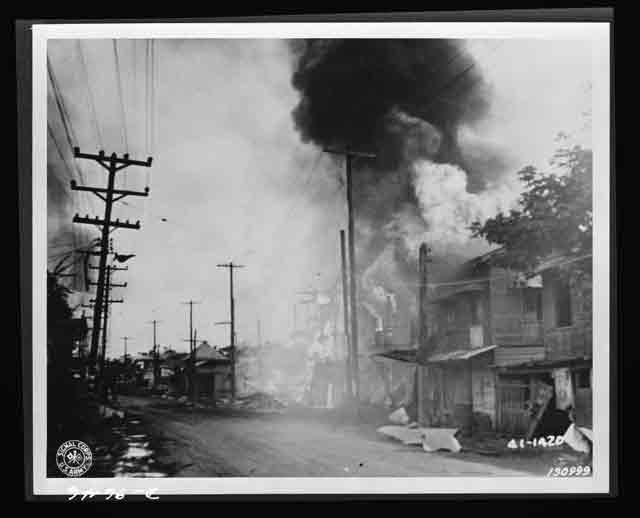 |
| A burning building along Taft Avenue which was hit during the Japanese air raid in Barrio, Paranque, December 13, 1941, the Philippine Islands (Libary of Congress) |
In the Philippines, the Japanese Air Force continues devastating raids on Clark, Del Carmen, and Nichols airfields, destroying many more aircraft on the ground. The US Army Air Force is fighting back and scores some successes. First Lieutenant Boyd D "Buzz" Wagner of the 17th Pursuit Squadron (Interceptor), 24th Pursuit Group (Interceptor), shoots down four Japanese airplanes near Aparri while on a reconnaissance mission over the Japanese invaders in northern Luzon. In doing so, Wagner apparently violates orders to avoid combat, later claiming that he "accidentally" stumbled into the dozen Japanese fighters. However, the fleet of bombers with which the Americans began the campaign is virtually gone and few fighters remain.
 |
| "Picture Post" magazine for 13 December 1941. The cover features General Martel, "The man against Hitler's tanks." |
In Burma, a small Japanese force makes rapid progress against token opposition. The RAF is forced to evacuate an airfield at Victoria Point on the Kra Isthmus, which the Japanese quickly take and use. While Victoria Point is far to the south of Rangoon, the airfield is perfectly positioned for the Japanese to use for missions both over Burma and south toward Singapore.
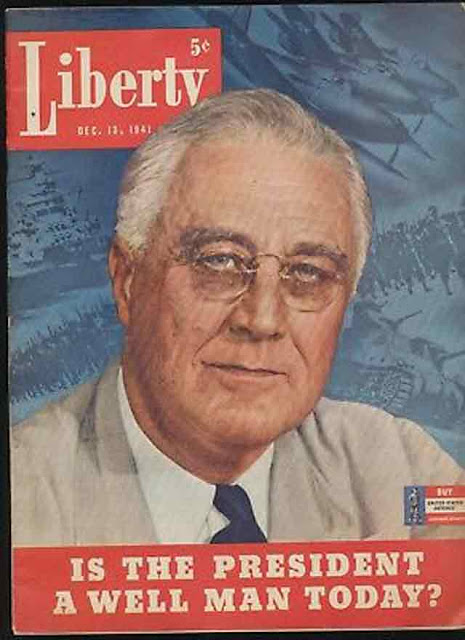 |
| Liberty magazine of 13 December 1941 poses the question, "Is the President A Well Man Today?" That actually is an excellent question, because President Roosevelt, in fact, is much sicker than this commonly known. However, he still is able to hide it very well. |
American Homefront: The US Department of Justice is working fast to intern suspected foreign sympathizers. To date, it has imprisoned 585 Japanese and 187 German citizens. The US Congress passes an amendment to the Selective Service laws which authorizes the military to keep soldiers enlisted beyond their scheduled expiration date - meaning, until things change, everyone is in for the duration as the military sees fit.
 |
| "Love Story Magazine" for 13 December 1941. This includes articles such as "The Technique of Make-up," "Your Stars and You," and "Married in Haste." |
December 1941December 1, 1941: Hitler Fires von RundstedtDecember 2, 1941: Climb Mount NiitakaDecember 3, 1941: Hints of Trouble in the PacificDecember 4, 1941: Soviets Plan CounteroffensiveDecember 5, 1941: Soviets Counterattack at KalininDecember 6, 1941: Soviet Counterattack at Moscow BroadensDecember 7, 1941: Japan Attacks Pearl HarborDecember 8, 1941: US Enters World War IIDecember 9, 1941: German Retreat At MoscowDecember 10, 1941: HMS Prince of Wales and Repulse SunkDecember 11, 1941: Hitler Declares War on USDecember 12, 1941: Japanese in BurmaDecember 13, 1941: Battle of Cape BonDecember 14, 1941: Hitler Forbids WithdrawalsDecember 15, 1941: The Liepaja MassacreDecember 16, 1941: Japan Invades BorneoDecember 17, 1941: US Military ShakeupDecember 18, 1941: Hitler Lays Down the LawDecember 19, 1941: Brauchitsch Goes HomeDecember 20, 1941: Flying Tigers in ActionDecember 21, 1941: The Bogdanovka MassacreDecember 22, 1941: Major Japanese Landings North of ManilaDecember 23, 1941: Wake Island Falls to JapanDecember 24, 1941: Atrocities in Hong KongDecember 25, 1941: Japan Takes Hong KongDecember 26, 1941: Soviets Land in the CrimeaDecember 27, 1941: Commandos Raid NorwayDecember 28, 1941: Operation Anthropoid BeginsDecember 29, 1941: Soviet Landings at FeodosiaDecember 30, 1941: Race for BataanDecember 31, 1941: Nimitz in Charge2020
